Abstract
The chemical communication system used to attract mates involves not only the overt chemical signals but also indirectly a great deal of chemistry in the emitter and receiver. As an example, in emitting female moths, this includes enzymes (and cofactors, mRNA, genes) of the pheromone biosynthetic pathways, hormones (and genes) involved in controlling pheromone production, receptors and second messengers for the hormones, and host plant cues that control release of the hormone. In receiving male moths, this includes the chemistry of pheromone transportation in antennal olfactory hairs (binding proteins and sensillar esterases) and the chemistry of signal transduction, which includes specific dendritic pheromone receptors and a rapid inositol triphosphate second messenger signal. A fluctuating plume structure is an integral part of the signal since the antennal receptors need intermittent stimulation to sustain upwind flight. Input from the hundreds of thousands of sensory cells is processed and integrated with other modalities in the central nervous system, but many unknown factors modulate the information before it is fed to motor neurons for behavioral responses. An unknown brain control center for pheromone perception is discussed relative to data from behavioral-threshold studies showing modulation by biogenic amines, such as octopamine and serotonin, from genetic studies on pheromone discrimination, and from behavioral and electrophysiological studies with behavioral antagonists.
Full text
PDF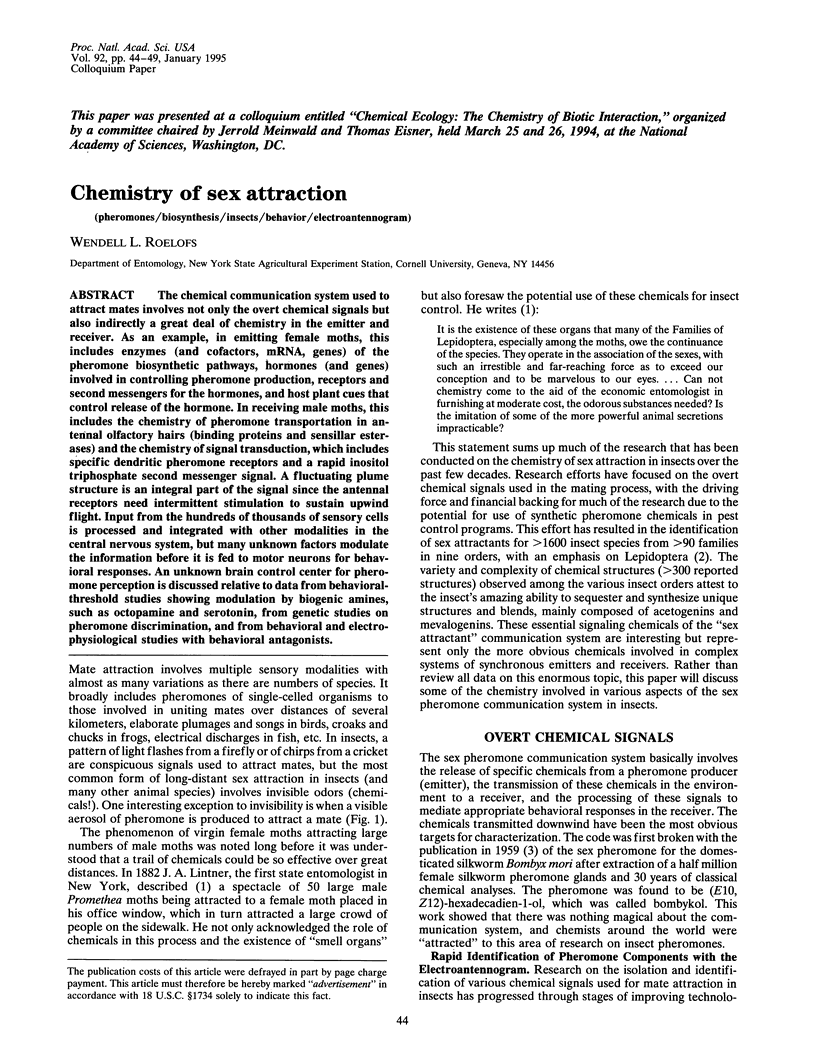
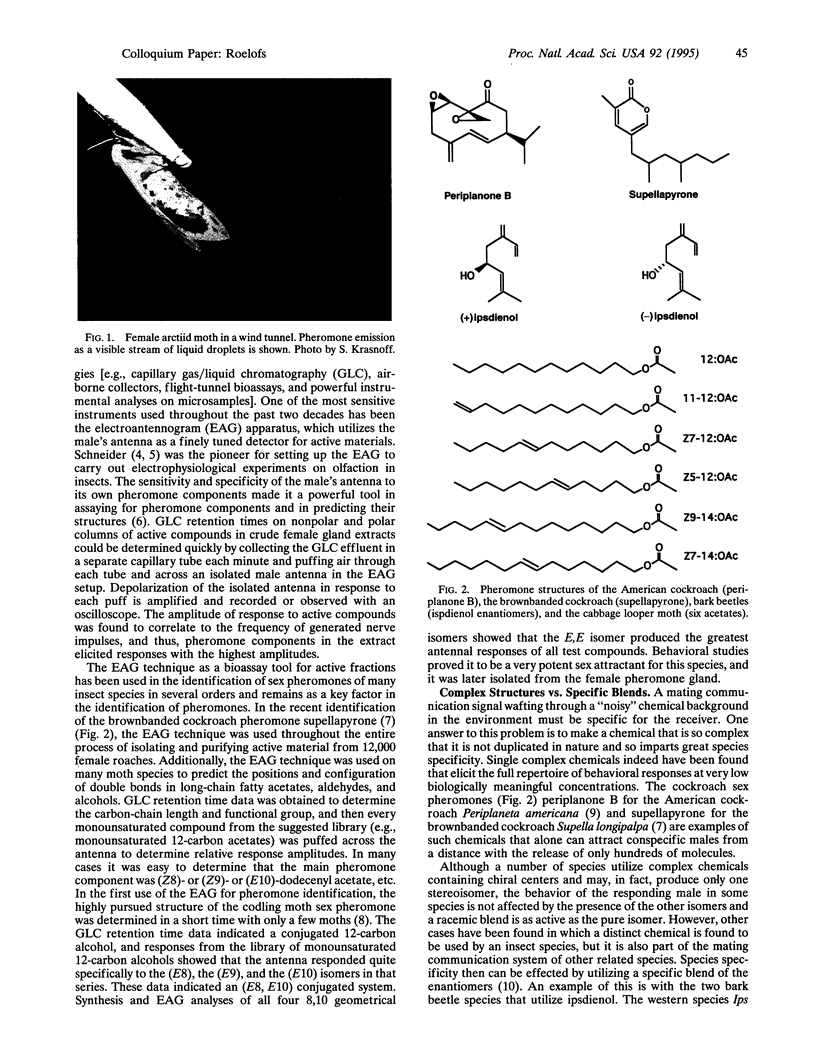
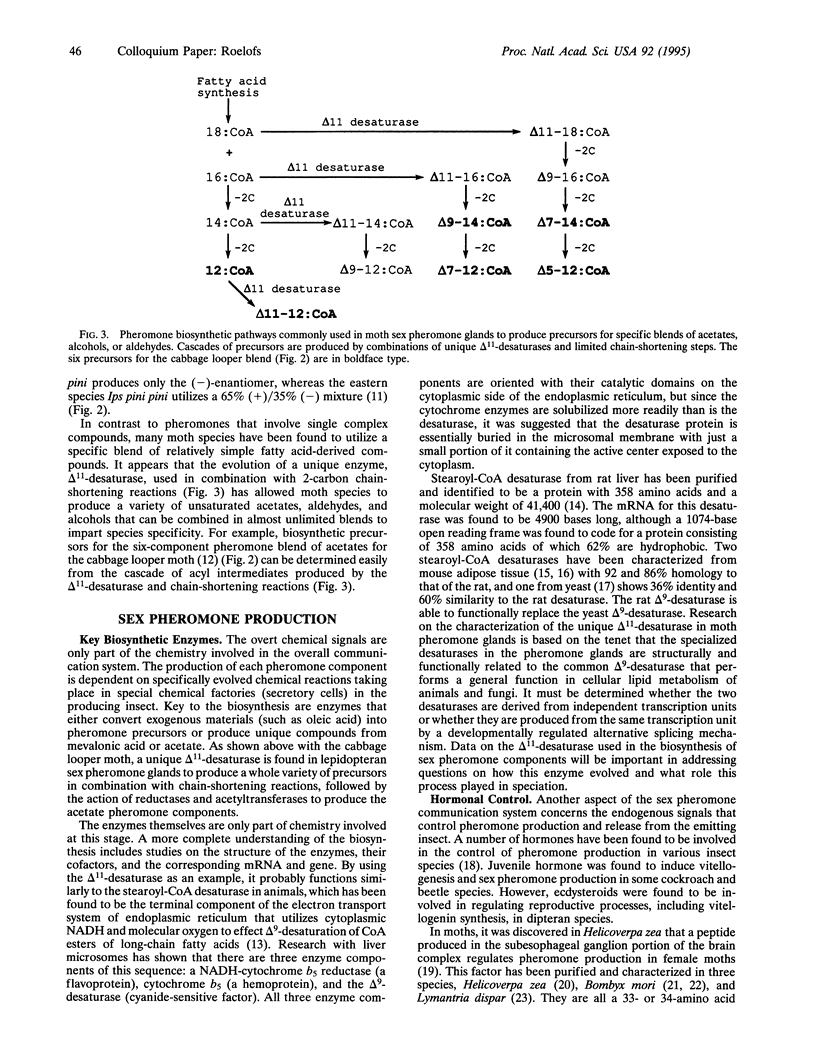
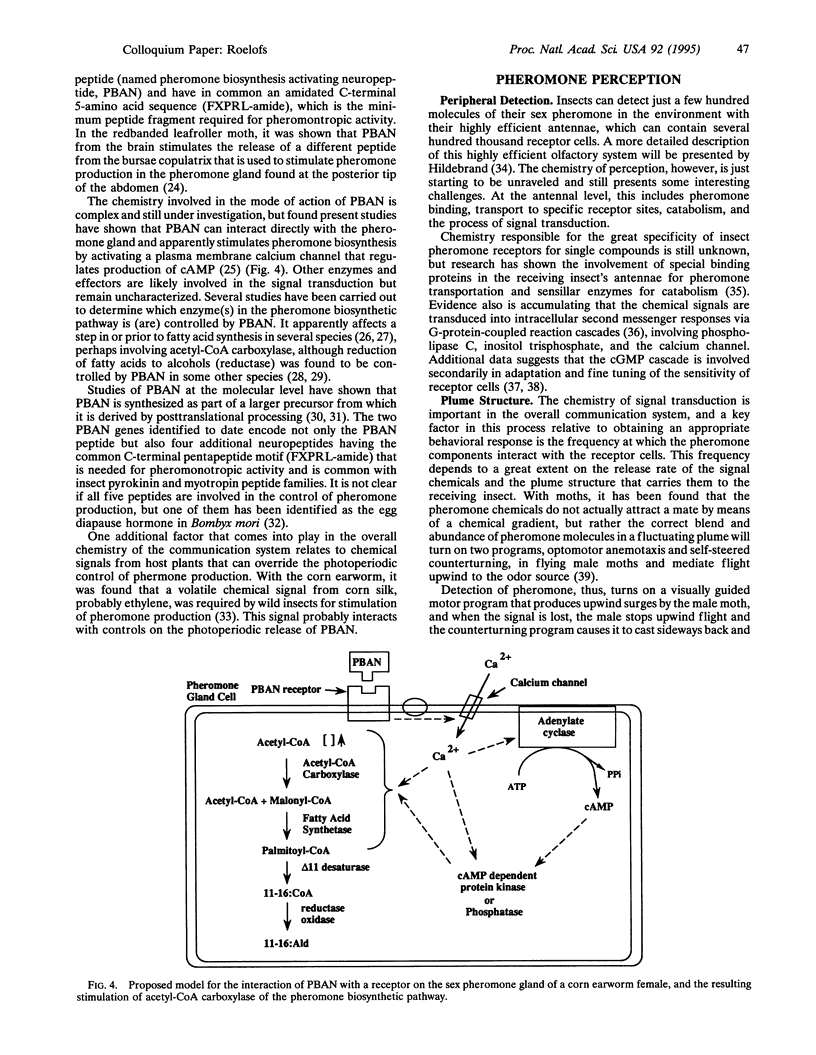
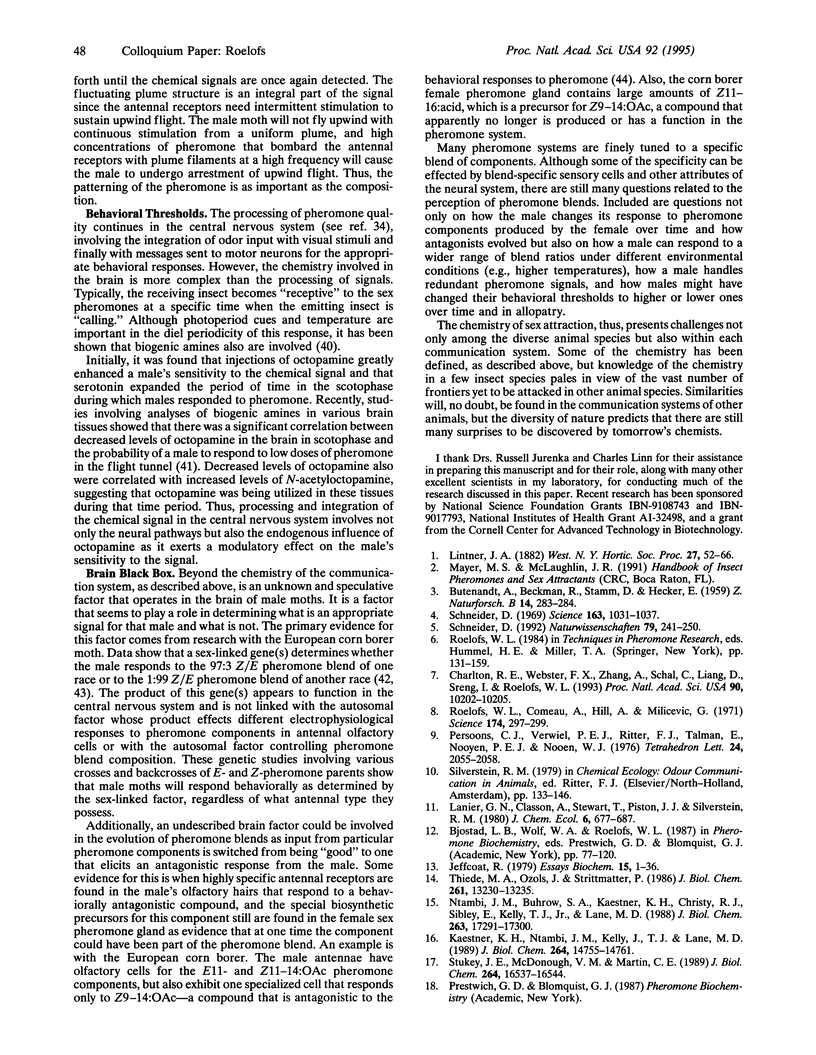
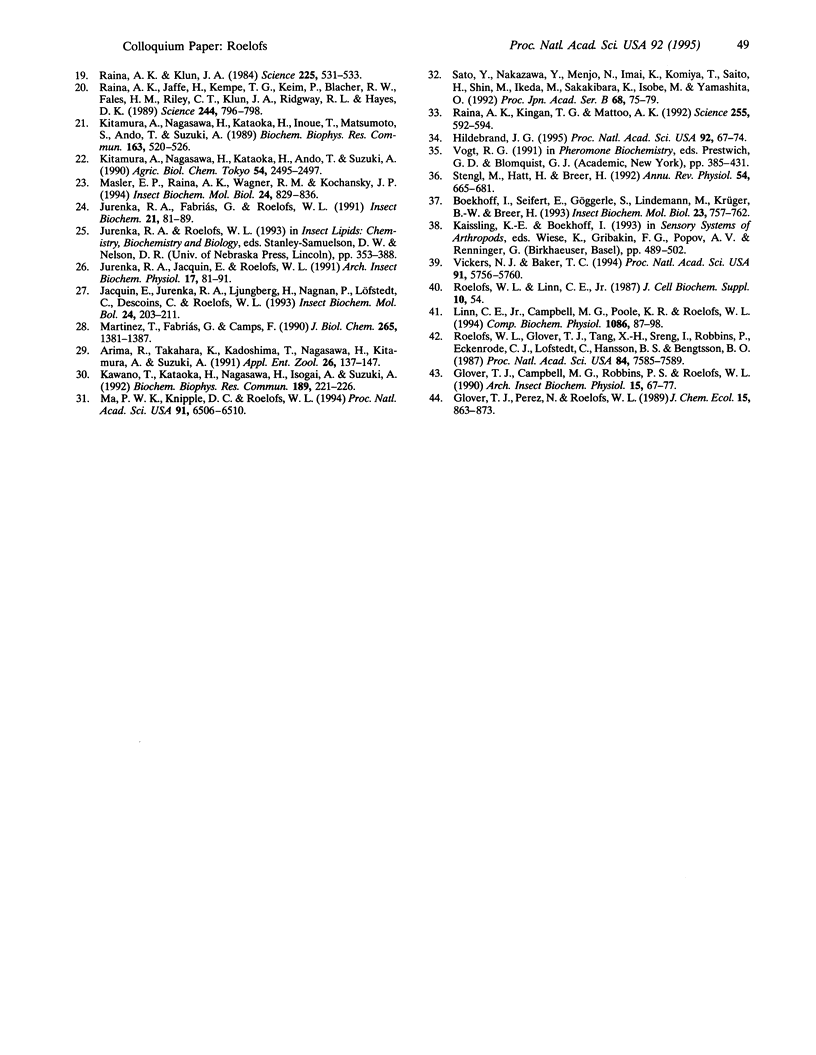
Images in this article
Selected References
These references are in PubMed. This may not be the complete list of references from this article.
- Charlton R. E., Webster F. X., Zhang A., Schal C., Liang D., Sreng I., Roelofs W. L. Sex pheromone for the brownbanded cockroach is an unusual dialkyl-substituted alpha-pyrone. Proc Natl Acad Sci U S A. 1993 Nov 1;90(21):10202–10205. doi: 10.1073/pnas.90.21.10202. [DOI] [PMC free article] [PubMed] [Google Scholar]
- Hildebrand J. G. Analysis of chemical signals by nervous systems. Proc Natl Acad Sci U S A. 1995 Jan 3;92(1):67–74. doi: 10.1073/pnas.92.1.67. [DOI] [PMC free article] [PubMed] [Google Scholar]
- Jeffcoat R. The biosynthesis of unsaturated fatty acids and its control in mammalian liver. Essays Biochem. 1979;15:1–36. [PubMed] [Google Scholar]
- Kaestner K. H., Ntambi J. M., Kelly T. J., Jr, Lane M. D. Differentiation-induced gene expression in 3T3-L1 preadipocytes. A second differentially expressed gene encoding stearoyl-CoA desaturase. J Biol Chem. 1989 Sep 5;264(25):14755–14761. [PubMed] [Google Scholar]
- Kawano T., Kataoka H., Nagasawa H., Isogai A., Suzuki A. cDNA cloning and sequence determination of the pheromone biosynthesis activating neuropeptide of the silkworm, Bombyx mori. Biochem Biophys Res Commun. 1992 Nov 30;189(1):221–226. doi: 10.1016/0006-291x(92)91547-4. [DOI] [PubMed] [Google Scholar]
- Kitamura A., Nagasawa H., Kataoka H., Ando T., Suzuki A. Amino acid sequence of pheromone biosynthesis activating neuropeptide-II (PBAN-II) of the silkmoth, Bombyx mori. Agric Biol Chem. 1990 Sep;54(9):2495–2497. [PubMed] [Google Scholar]
- Kitamura A., Nagasawa H., Kataoka H., Inoue T., Matsumoto S., Ando T., Suzuki A. Amino acid sequence of pheromone-biosynthesis-activating neuropeptide (PBAN) of the silkworm, Bombyx mori. Biochem Biophys Res Commun. 1989 Aug 30;163(1):520–526. doi: 10.1016/0006-291x(89)92168-2. [DOI] [PubMed] [Google Scholar]
- Ma P. W., Knipple D. C., Roelofs W. L. Structural organization of the Helicoverpa zea gene encoding the precursor protein for pheromone biosynthesis-activating neuropeptide and other neuropeptides. Proc Natl Acad Sci U S A. 1994 Jul 5;91(14):6506–6510. doi: 10.1073/pnas.91.14.6506. [DOI] [PMC free article] [PubMed] [Google Scholar]
- Martinez T., Fabriás G., Camps F. Sex pheromone biosynthetic pathway in Spodoptera littoralis and its activation by a neurohormone. J Biol Chem. 1990 Jan 25;265(3):1381–1387. [PubMed] [Google Scholar]
- Masler E. P., Raina A. K., Wagner R. M., Kochansky J. P. Isolation and identification of a pheromonotropic neuropeptide from the brain-suboesophageal ganglion complex of Lymantria dispar: a new member of the PBAN family. Insect Biochem Mol Biol. 1994 Sep;24(8):829–836. doi: 10.1016/0965-1748(94)90111-2. [DOI] [PubMed] [Google Scholar]
- Ntambi J. M., Buhrow S. A., Kaestner K. H., Christy R. J., Sibley E., Kelly T. J., Jr, Lane M. D. Differentiation-induced gene expression in 3T3-L1 preadipocytes. Characterization of a differentially expressed gene encoding stearoyl-CoA desaturase. J Biol Chem. 1988 Nov 25;263(33):17291–17300. [PubMed] [Google Scholar]
- Raina A. K., Jaffe H., Kempe T. G., Keim P., Blacher R. W., Fales H. M., Riley C. T., Klun J. A., Ridgway R. L., Hayes D. K. Identification of a neuropeptide hormone that regulates sex pheromone production in female moths. Science. 1989 May 19;244(4906):796–798. doi: 10.1126/science.244.4906.796. [DOI] [PubMed] [Google Scholar]
- Raina A. K., Kingan T. G., Mattoo A. K. Chemical signals from host plant and sexual behavior in a moth. Science. 1992 Jan 31;255(5044):592–594. doi: 10.1126/science.255.5044.592. [DOI] [PubMed] [Google Scholar]
- Raina A. K., Klun J. A. Brain factor control of sex pheromone production in the female corn earworm moth. Science. 1984 Aug 3;225(4661):531–533. doi: 10.1126/science.225.4661.531. [DOI] [PubMed] [Google Scholar]
- Roelofs W., Comeau A., Hill A., Milicevic G. Sex attractant of the codling moth: characterization with electroantennogram technique. Science. 1971 Oct 15;174(4006):297–299. doi: 10.1126/science.174.4006.297. [DOI] [PubMed] [Google Scholar]
- Roelofs W., Glover T., Tang X. H., Sreng I., Robbins P., Eckenrode C., Löfstedt C., Hansson B. S., Bengtsson B. O. Sex pheromone production and perception in European corn borer moths is determined by both autosomal and sex-linked genes. Proc Natl Acad Sci U S A. 1987 Nov;84(21):7585–7589. doi: 10.1073/pnas.84.21.7585. [DOI] [PMC free article] [PubMed] [Google Scholar]
- Schneider D. Insect olfaction: deciphering system for chemical messages. Science. 1969 Mar 7;163(3871):1031–1037. doi: 10.1126/science.163.3871.1031. [DOI] [PubMed] [Google Scholar]
- Stengl M., Hatt H., Breer H. Peripheral processes in insect olfaction. Annu Rev Physiol. 1992;54:665–681. doi: 10.1146/annurev.ph.54.030192.003313. [DOI] [PubMed] [Google Scholar]
- Stukey J. E., McDonough V. M., Martin C. E. Isolation and characterization of OLE1, a gene affecting fatty acid desaturation from Saccharomyces cerevisiae. J Biol Chem. 1989 Oct 5;264(28):16537–16544. [PubMed] [Google Scholar]
- Thiede M. A., Ozols J., Strittmatter P. Construction and sequence of cDNA for rat liver stearyl coenzyme A desaturase. J Biol Chem. 1986 Oct 5;261(28):13230–13235. [PubMed] [Google Scholar]
- Vickers N. J., Baker T. C. Reiterative responses to single strands of odor promote sustained upwind flight and odor source location by moths. Proc Natl Acad Sci U S A. 1994 Jun 21;91(13):5756–5760. doi: 10.1073/pnas.91.13.5756. [DOI] [PMC free article] [PubMed] [Google Scholar]



